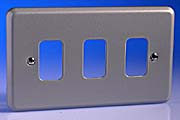The normal method of wiring a switch to an inertia lamp is to use the ceiling rose as a junction box. This means instead of the radial supply going up and down the wall to switches it only goes lamp to lamp. Only the line supply and return go to switch for each lamp there is no neutral.
Do remember BOTH line and neutral are classed as LIVE. So the L on any socket or switch stands for LINE not LIVE. This is now the convention line can also be called "phase" Unless you realise this it is easy to miss read what people say.
Anyway to continue with an outside lamp we want a round cable which a gland can seal on so it is common not to use the same system as with interior lamps. Also water can cause some real problems with neutral earth faults specially where the supply is RCD protected so often with an outside lamp we use a double pole switch which switches both line and neutral. So with outside lamps the neutral is taken to the switch.
I stand to be corrected here but as far as I am aware the only way to mix double pole and two way switches in one unit is to use the grid switch option. This means you buy a back box as with any switch, then a grid to take the number of switches required, Then the switches, and finally a front plate. To get 3 would normally mean this sort of front plate.
By not switching the neutral you could get the slimmer switch like this
but I would always switch the neutral for an outside lamp.
One thing to remember an intermediate switch and a double pole switch look very similar but have a completely different functionality. Looking for a switch with 4 terminals is not good enough you must go for double pole.
So you would need
One double pole switch and
One one way switch and
One two way switch and
a 3 gang grid frame which with the range linked to comes with grid plate other makes you may need to buy separate. Which will all need a two gang box.
I will guess the reason it does not work is the neutral is missing. Before RCD's were in common use it would be common to switch only the line supply. To convert from twin and earth to a round flex is was common to fit a junction box. This would be wired like a ceiling rose with a permanent live supply then split off the line to go to switch and back then another cable from JB to outside lamp. As with a sealing rose four connections in the JB Earth, Line permanent, Line switched, Neutral. It could have three or four cables extra cable if not end of radial circuit. However unlike the ceiling rose finding it can be something else.
Where the orignal work was DIY you can get all sorts. Including lights wired in series where the guy did not realise there was no neutral at the light switch. The Wiki section shows you how they should be wired but it may not follow normal system.
Today we have radio controlled switches
like shown here these have made live easy although as far as I can see
this range is single pole the normal method would be to fit a FCU before the receiver so it could be isolated both in case of a fault and to program when the supply is from a 9 volt battery not mains.



